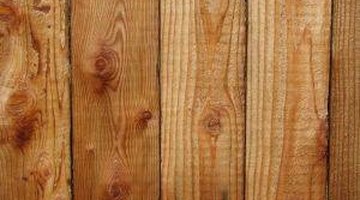How to Install a Wooden Stockade Fence
Wood stockade fencing is easier to install than ever before due to the premade panels. Stockade fencing can be a great addition to your landscape design. It can also provide privacy and noise reduction. In some cases the fence is used to hide areas like old car collections or work areas from the rest of the yard.

It also makes dramatic backdrops for landscaping and water features. This project can be done by one person but is made much easier with the help of a friend, as the panels can be very heavy to lift by yourself.
-
Plan for the fence. Check with the local building code office to see if you need a permit to install fencing and ask for a copy of the regulations. Many areas have height restrictions on fencing. Check with the utility companies to make sure there are no underground wires or gas lines where you will be digging. Have a copy of the survey for the property to make sure the fencing is on your property and you are not cutting off any easements or right-of-ways.
-
Measure your fencing. Set stakes at each corner or end, and run string between them. Measure each panel you intend to use from one corner to the next as each panel will not be exactly the measurement you purchased. It's best to lay the panels out where you intend to use them. This method may take a little longer, but in the long run it can save you much aggravation if the panels don't line up with the posts.
-
Set stakes for your line posts by measure on center from one post to the next using the panel measurement. Set the stakes so they are touching the line string.
-
Dig your post holes. Dig the post holes 10 to 12 inches around and 6 inches. Measure from the top rail of the fence panel to the ground and add 6 inches. That is how deep the holes need to be. Dig the bottom of the hole larger than the top to anchor the cement.
-
Set the end and corner posts. Place 6 inches of gravel in the holes to keep water away from the bottom of the posts. Tamp down the gravel. Mix cement and let it set up. Center your end and corner posts into the holes and fill around it with cement. Use a post level to make sure the posts are plumb and level. Overfill the cement a little and trowel it downward to keep water from pooling around the posts.
-
Set the line posts. Tie string to the top of the end and corner posts to give yourself a height guide. Set the line posts in the same way you did the corners and ends. If the post is too long, cut off the top of the post. If it is too short, add some extra gravel. Allow all the cement to set for 24 to 48 hours, depending on humidity in your area.
-
Install the panels. Place the panel so that the ends are lined up in the center of the posts. Place a level on the top rail to make sure the panel is level. Screw or nail the panels through the top and bottom rails. The panels can also be attached by nailing them through the picket and rail into the post. The way you attach the panels will be determined by the height you want them to be.
Things You Will Need
- Fence panels
- 4-by-4-inch posts
- Post hole digger
- Cement
- Stakes and string
- Measuring tape
- Level
- Circular saw
- Drill
- 2-by-4 boards
- Stainless steel screws
- Hammer
- Post level
- Trowel
Photo Credits
- Diane Groves
- Diane Groves
More Articles



